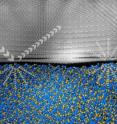Graphene for real-world devices
Related images
(click to enlarge)
Graphene, a one-atom-thick form of the carbon material graphite, has been hailed as a wonder material -- strong, light, nearly transparent, and an excellent conductor of electricity and heat. But a number of practical challenges must be overcome before it can emerge as a replacement for silicon and other materials in microprocessors and next-generation energy devices. One particular challenge concerns the question of how graphene sheets can be used in real devices.
"When you fabricate devices using graphene, you have to support the graphene on a substrate and doing so actually suppresses the high thermal conductivity of graphene," said Li Shi, a professor of mechanical engineering at The University of Texas at Austin, whose work is partially funded by the National Science Foundation (NSF).
Thermal conductivity is critical in electronics, especially as components shrink to the nanoscale. High thermal conductivity is a good thing for electronic devices fabricated from graphene. It means the device can spread the heat it generates to prevent the formation of local hot spots. However, in the case of graphene, when the needed supporting materials are also used, graphene loses some of the superhigh thermal conductivity that is predicted for its idealized state when it is freely suspended in a vacuum.
In a paper published in September 2013 in the Proceedings of the National Academy of Sciences, Shi, along with graduate research assistant Mir Mohammad Sadeghi and post-doctoral fellow Insun Jo, designed an experiment to observe the effects of thermal conductivity when the thickness of graphene supported on an amorphous glass layer was increased.
They observed that thermal conductivity increased as the number of layers grew from a single one-atom layer to as thick as 34 layers. However, even at 34 layers, the thermal conductivity had not recovered to the point where it was as high as bulk graphite, which is an excellent heat conductor.
These findings are leading Shi and others to explore novel ways of supporting or connecting graphene with the macroscopic world, including three-dimensional interconnected foam structures of graphene and ultrathin graphite, or the use of hexagonal boron nitride, which has nearly the same crystal structure as graphene.
"One of our objectives is to use graphene and other layered materials to make flexible electronic devices," Shi explained. "And those devices will be made on plastic substrates, which are flexible, but also have very low thermal conductivity. When you run current through the devices, a lot of them fail. The heat cannot be dissipated effectively, so it becomes very hot and it just melts the substrate."
Melting isn't the only problem. As temperatures get higher, the flexible polymer substrate can become a molten and rubber-like material that breaks the electronic materials built on top and causes tiny conducting wires in electronic devices to easily fail.
"In general, a hot chip is not good for the devices," Shi said. "The transistors will switch slower and will require more power."
Shi has been exploring the physical properties of graphene-based materials for more than a decade. He co-authored a 2001 paper in Physical Review Letters that reported the first measurement of high thermal conductivity in individual carbon nanotubes, a cousin of graphene. He also co-authored a 2010 paper in Science that provided critical insight into the thermal conductivity and thermal transport in single layer graphene supported on a substrate.
Shi is trying to answer fundamental questions about how phonons -- the vibrations of atoms in solids -- transport heat. Phonons are like electrons or photons (light particles), in that they carry heat energy. However, much less is known about phonons because their effects are less apparent at the macro-scale at which we live.
"This fundamental study allowed us to understand the intrinsic physics of the scattering of lattice waves," Shi said.
Shi's experiments let his team infer how phonons scatter as a function of thickness of the graphene layers, based on observations of how the thermal conductivity varied with different numbers of layers.
To gather these insights, his team conducted theoretical calculations using the Stampede supercomputer at the Texas Advanced Computing Center (TACC) at The University of Texas at Austin. Stampede is funded by the National Science Foundation (NSF) through award ACI-1134872.
The simulations led them to better understand their experimental results.
"To really understand the physics, you need to include additional theoretical calculations. That's why we use the supercomputers at TACC," Shi said. "When you do an experiment, you see a trend, but without doing the calculations you don't really know what it means. The combination of the two is very powerful. If you just do one without doing the other, you might not develop the understanding needed."
Most of the thermal systems used today are based on legacy technologies, according to Shi. Copper and aluminum serve as heat sink materials in computers; molten salts and paraffin wax are used as the storage medium of energy in thermal storage devices; and to perform thermoelectric conversion for waste heat recovery, we use materials like bismuth telluride or lead telluride that contain elements that are neither abundant in the earth's crust nor environmentally friendly.
"We're really limited by the materials," Shi said. "Can we come up with more effective materials to replace copper interconnects and copper heat-sinks, or replace silicon transistors? Can we develop thermally stable insulators for applications like fire protection? I think in 10 years, new materials will be discovered and implemented to replace these legacy technologies."
Recently, Shi has been exploring how multi-layered graphene can recover some of the high thermal conductivity that is lost as graphene is placed on a glass substrate, and also looking into other crystalline materials for supporting graphene
Shi and his team are experimenting and modeling new dielectric supports, like boron nitride, which has a comparable crystal structure to graphene. The hope is that its similar crystal structure will lead to better thermal conductivity and less phonon scattering when they are used to support graphene. In a recent paper in Applied Physical Letters, Shi and Steve Cronin's team at University of Southern California reported their investigation of thermal transport across a graphene/boron-nitride interface.
The results suggest the importance of improving the interface quality to increase the interface's conductance.
Another line of Shi's research looks at materials for thermal energy storage. Writing in the December 2013 issue of the journal Energy and Environmental Science, Shi's team showed that ultrathin graphene foams can be used to increase the power capacity of thermal storage devices by increasing the rate that heat can be charged and discharged into the phase change materials used to store the thermal energy.
"The increased thermal cycling stability, and applicability to a diverse range of phase change materials suggests that ultra-thin graphite foam composites are a promising route to achieving the high power capacity targets of a number of thermal storage applications, including building and vehicle heating and cooling, solar thermal harvesting, and thermal management of electrochemical energy storage and electronic devices," said Michael Pettes, a professor of mechanical engineering at the University of Connecticut and co-author of the paper.
"It is Shi's fundamental work on nanoscale materials including graphene that has guided the design of scalable materials which can benefit from nanostructuring and provide possibly revolutionary societal benefits," Pettes said.
The common thread for all this research is the development of an understanding of how the fundamental energy carriers, including electrons, photons, phonons and molecules, are transported and coupled to each other in materials.
"Professor Shi has pioneered work on the measurements of phonon transport at the nano-scale and has undertaken measurements across a range of nano-scale systems," said Sumant Acharya, a program officer in the Thermal Transport Processes Program at the NSF. "He was among the first to report measurements showing the important effect of a substrate on thermal conductivity reduction in graphene."
The NSF has also supported Shi on the development of low-cost silicide thermoelectric materials with the intent of fostering the development of thermoelectric-based waste heat recovery from automobiles.
"Professor Shi is a leader in the field of nano-scale heat transport, and I am pleased that the NSF has been able to support many of Professor Shi's groundbreaking research," Acharya said.
Despite a long history exploring and designing with the material, Shi doesn't claim graphene will always be superior to other materials.
"It has exciting prospects for applications," he said. "And there's great physics involved."
Source: University of Texas at Austin, Texas Advanced Computing Center
Other sources
- Research in phonon scattering sheds more light on graphene as a replacement for siliconfrom PhysorgTue, 6 May 2014, 18:20:21 UTC

